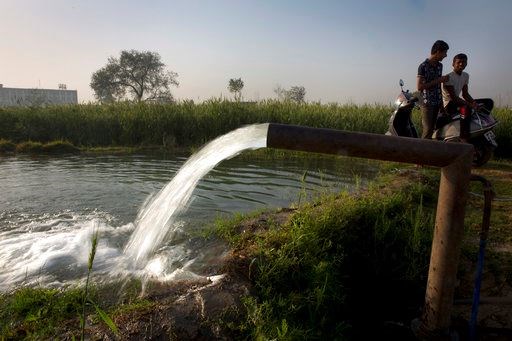 |
| Indians sit on a two-wheeler and talk as water from a bore well irrigates their field on the World Water Day on the outskirts of New Delhi, India, Wednesday, March 22, 2017. India has the world's highest number of people without access to clean water. UNICEF says nearly 78 million Indians - about 5 percent of the country's 1.3 billion population - must make do with contaminated water sources or buy water at high rates. (AP Photo/Manish Swarup) |
NAI BASTI VILLAGE, India (AP) — Schoolchildren cheered and village women clapped as a gush of clean water flowed through a set of gleaming steel taps connected to a newly installed water filtration plant in a dusty north Indian village.
Nai Basti is a mere 55 kilometers (35 miles) east of the capital, New Delhi, but access to clean drinking water was a dream for the villagers until Wednesday, when the filtration plant began functioning at a village elementary school.
India has the world's highest number of people without access to clean water. According to UNICEF, the U.N.'s children's agency, nearly 78 million Indians — or about 5 percent of the country's 1.3 billion population — must make do with contaminated water sources or buy water at high rates.
The lack of clean water contributes to increases in stomach ailments, diarrheal diseases and deaths from waterborne diseases. Around 140,000 children die of diarrheal disease in India each year, a third of the 315,000 such deaths of children worldwide.
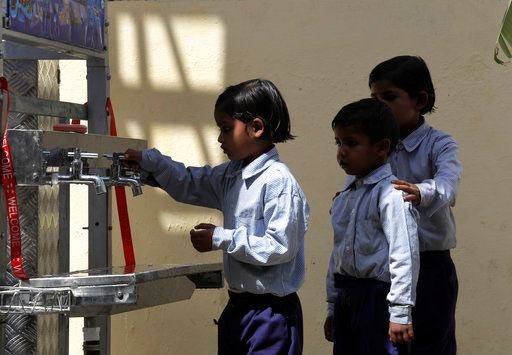 |
| Schoolchildren line up to drink water from a newly set up water filtration tower at their school in Nai Basti Village, some 55 kilometers (35 miles) from in New Delhi, India, Wednesday, March 22, 2017. Schoolchildren cheered and village women clapped as a gush of clean water flowed through a set of gleaming steel taps connected to a newly installed water filtration plant in a dusty north Indian village on Wednesday. (AP Photo/Manish Swarup) |
The US-based non-governmental organization, Planet Water Foundation, which has built the filtration system in Nai Basti, chose to activate it March 22, marked globally as World Water Day. The nonprofit plans to give access to clean drinking water to 24,000 people through 24 projects in five countries on this day.
School staff and villagers in Nai Basti said access to clean water would transform their lives. Apart from ending the effort of pumping every bucket they need for their use, it would also bring down waterborne diseases sharply.
"Earlier, the children used to drink dirty water. This was groundwater drawn from a bore-well by using a hand pump. They used to fall sick frequently and would not attend school," said Vinod Sharma, principal of the Brahmaved Inter College in Nai Basti. "We expect attendance to reach 100 percent. And the residents of the village will have access to this water as well," he said.
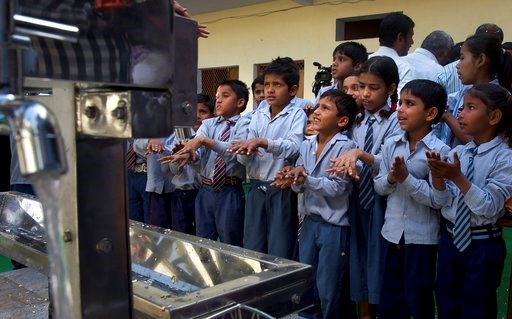 |
| Schoolchildren learn to wash their hands before drinking water from newly set up water filtration tower in their school in Nai Basti Village, some 55 kilometers (35 miles) from in New Delhi, India, Wednesday, March 22, 2017. Schoolchildren cheered and village women clapped as a gush of clean water flowed through a set of gleaming steel taps connected to a newly installed water filtration plant in a dusty north Indian village on Wednesday. (AP Photo/Manish Swarup) |
Installing the filtration system in the school serves the dual purpose of teaching children basic hygiene such as washing their hands before meals and after using the toilet.
In many ways Nai Basti's water woes reflect the severe water shortages faced across the country. As rivers and streams run dry, villagers are forced to dig bore-wells and pump up increasingly polluted groundwater. But decades of extracting groundwater for their daily needs has led to a precipitous drop in the groundwater table levels across the country, threatening environmental and human disaster.
India faces chronic water shortages. With climate change, the country's annual monsoon rains have become more erratic, and traditional water reservoirs have shrunk.
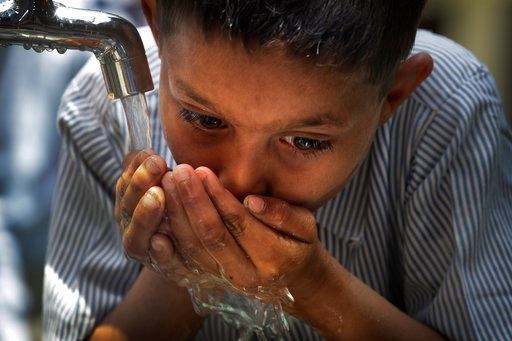 |
| A boy drinks water from a newly set up water filtration tower in his school provided by Planet Water foundation, a non-governmental organization based in U.S. in Nai Basti Village, some 55 kilometers (35 miles) from in New Delhi, India, Wednesday, March 22, 2017. Schoolchildren cheered and village women clapped as a gush of clean water flowed through a set of gleaming steel taps connected to a newly installed water filtration plant in a dusty north Indian village on Wednesday. (AP Photo/Manish Swarup) |
The situation is worse in the cities, where water tables have plunged hundreds of feet, leaving people entirely dependent on tankers which supply water at prohibitive prices. In major cities this has led to the creation of powerful water "mafias," which control water supplies to neighborhoods.
Nai Basti residents foresee a healthier future with their new access to clean water.
"My worries were for my children who would often fall ill from drinking unfiltered water. They were falling behind in their studies from missing school," said Jyoti, a housewife, who uses one name.
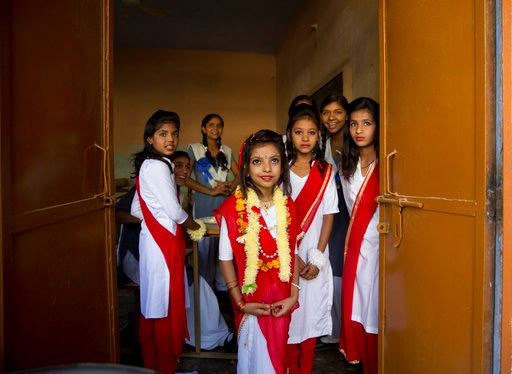 |
| Schoolchildren wait to perform during the inauguration ceremony of a water filtration tower at their school in Nai Basti Village, some 55 kilometers (35 miles) from in New Delhi, India, Wednesday, March 22, 2017. In Nai Bastti access to clean drinking water was a dream for the villagers till Wednesday, when the water filtration plant began functioning in an elementary school in the village. India has the world's highest number of people without access to clean water. UNICEF says nearly 78 million Indians - about 5 percent of the country's 1.3 billion population - must make do with contaminated water sources or buy water at high rates. (AP Photo/Manish Swarup) |
"That won't be a problem anymore," she smiled.
Ganguly reported from Nai Basti village.
Copyright 2017 The Associated Press. All rights reserved.
This material may not be published, broadcast, rewritten or redistributed.
Page created on 3/22/2017 6:11:58 PM
Last edited 7/7/2017 7:42:55 PM





